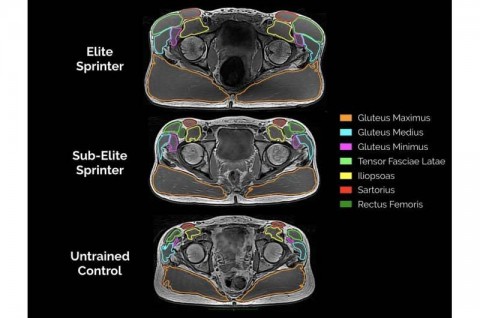There seems to be a school of thought when it comes to resistance training that you're either training for performance or for aesthetics. It's either bodybuilding or strength and conditiong. Built for show or for go. It was as though the two goals were mutually exclusive and could not overlap. Meatheads would mock those who couldn't build 20 inch arms. And athletes would point out all the gym rats that trip over their own feet during a game of football. But is that the case? If you train for hypertrophy i.e. size, does that mean you'll be useless on the playing field? New research says that's not the case. The study look at muscle volume and strength and compared this among three groups 1) elite sprinters n= 5, 2) sub-elite sprinters n= 26, and untrained controls n=11. All study subjects were male. Elite sprinters were defined as though that could run a 10.10 second 100 meter and sub-elite as though that could run the 100 m in 10.80 seconds. To put in perspective how fast a 10.10 second 100 metre is, only four Canadians have ever run a sub 10 second 100 m including Olympic champion Donovan Bailey and Olympic bronze medallist Andre De Grasse. The study subjects underwent MRIs to determine muscle volume of 23 lower limb muscles and 5 functional muscles. These were then correlated to 100 m times and isometric strength. What they found was that the muscularity of elite sprinters was greater in elite sprinters than sub-elite and both were greater than the controls. In particular the hip extensors showed the biggest difference among the groups and this accounted for 31-48% of the variability in 100 m times. Of the hip extensors it turns out the gluteus maximus alone accounted for 34-44 % of variance in 100...
How Hills Can Make You Faster
- Chris Collins
- Fitness
- 1979 Hits
- 0 Comments
-
Do you watch Fargo? I'm not talking about the movie, which was pretty good, but instead I'm referring to the TV show. We're just getting into it and it's awesome. But a word of warning to those with small children or that are squeamish...there's some killing and bloodshed. In fact the only thing that probably kills more than Billy Bob Thornton's character is speed. [caption id="attachment_5317" align="aligncenter" width="206"] Only speed kills more than Billy Bob Thornton's character on Fargo. That's the truth. In sports, speed kills. And for team sport athletes there are a number of things we can do to improve our speed. One thing I really like to incorporate into training to help with speed is to run some hills. Why Run Hills? Hills can be a great tool to help us get faster because it encourages proper foot contact. Imagine bounding up a fill as though jumping from one foot to the next. This doesn't really work we if land on the heel and try roll through the foot. If we used a heel-toe roll strategy we would lose all the momentum generated by bounding from one leg to the next. And we would slow right down. https://youtu.be/p2bYUE2roX4 The other great thing about running hills is the increased need for the arm action. The arms will help with propulsion and balance. Sometimes we'll see athletes start to move but not using their arms initially. In this case they are not as fast or explosive as they could be. Due to the inclination of the hill the arms become more of a necessity to assist with propulsion and to help us maintain balance as we jump from foot to foot. This can become more apparent when running downhill. Larger arm swings from the shoulder will help keep the arms...
The Best Cues for Coaching Speed
- Chris Collins
- Fitness
- 1994 Hits
- 2 Comments
-
This year Immaculata High School added a Sports Academy program for volleyball, soccer and basketball. And Okanagan Peak Performance Inc has been helping out with the strength and conditioning for this program. This morning we spent a good portion of the training session working on speed. And there a number of cues for speed to apply to almost every sport. Below are a number of things that were shared with the athletes to improve their speed 1. Knee Up - Toe Up One of the biggest factors that distinguish a runner from a sprinter is the degree of knee lift. The best sprinters in the world will flex the knee and hip to lift the frontside leg. [caption id="attachment_5282" align="aligncenter" width="300"] Knee up toe up on the front side leg. Runners on the other hand have minimal frontside knee and hip flexion. [caption id="attachment_5286" align="aligncenter" width="300"] Runners have less knee lift compared to sprinters. As for the toe up position this is what we refer to as a dorsi-flexed position. Toes pointed down is called plantar flexed. In order to take advantage of the stretch shortening cycle and elastic potential of the foot and ankle we want to be in the toe up position. 2. Longer is StrongerA longer core is a more stable core. If you trace from your tail bone to the base of your skull at the back of your head you can get an appreciation of the length of your spine. A taller posture lends to more stability than a shortened or slumped posture. The next time you watch a race pay attention to how tall the better athletes are compared to the later finishers. What I mean by tall is whether or not they get shorter with ground contact or not? If they can stay tall they...


